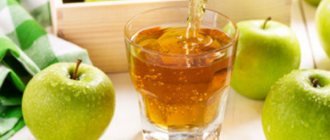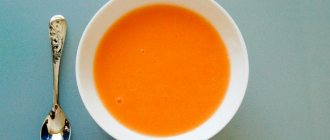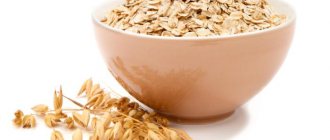Regardless of whether the baby started feeding at 3 or 6 months, whether he is a bottle-fed baby or a baby, his digestive system at 8 months is already sufficiently formed to include a variety of adult food products in the baby’s diet. It's time to think about how to provide your baby with complete, balanced complementary foods at 8 months, so that he doesn't have any problems with his health in general and the functioning of his stomach in particular. Some useful tips will help you deal with this issue.
At 8 months, the child should already be eating milk porridge, to which you can gradually begin to add a drop of butter
Features of complementary feeding for a seven-month-old baby
The main feature of complementary feeding for a 7-month-old baby who is breastfed or bottle-fed is the inclusion of meat products in the baby’s menu. The body is saturated with the necessary amount of protein, and the development of anemia is prevented.
Breastfed
Complementary feeding at 7 months during breastfeeding is an independent nutrition, replacing one, then several feedings with milk or formula. If the baby is fed with mother's milk, after each complementary feeding the baby is put to the breast, ensuring longer maintenance of lactation.
On artificial
Complementary feeding for a 7-month-old bottle-fed baby is mashed products containing one ingredient of soft consistency. Safe and healthy options would be mono-component puree, factory-produced porridge, home-cooked dishes: ground rice, fruit and vegetable purees. The baby's body also needs animal proteins. The menu should be supplemented with meat puree (rabbit, turkey, chicken, veal).
Breastfeeding at 9 months: main features
For a nine-month-old baby, mother's milk is still a necessary, important and healthy product.
It protects it from viruses and infections, stimulates the development of brain cells, helps digest other foods, plays an important role in the baby’s adaptation to the environment, and also ensures regular psychological and physical contact between the baby and mother. Therefore, if possible, breastfeeding should be continued at 9 months. At the same time, breast milk alone is no longer sufficient at this age. It is advisable to leave two breast meals (morning and evening), and during the day offer the child “adult” food. As a rule, by 9 months the baby has formed a food regimen consisting of 5 meals. Thus, the “non-dairy” diet will have three of them.
It is permissible to supplement the baby with milk, but after the main meal. Breastfeeding at 8-9-10 months at night is also not prohibited - if the baby sleeps restlessly and especially needs its mother at this time of day.
Basic principles of complementary feeding
Complementary feeding at 8 months while breastfeeding
The introduction of complementary foods to a seven-month-old baby has a number of features:
- Additional foods are given to the baby at the second morning feeding (9-11 am). The measure allows you to control the child’s reaction to food components.
- It is not recommended to feed your toddler “adult food” when he is tired or very hungry.
- If the baby refuses, do not insist. You need to try again after a few days.
- If the reaction to the new ingredient is normal, the next day you should double the dose. If an allergy appears or a change in stool, you should refrain from introducing complementary foods for a child up to one year old for three days.
- A dish of mixed foods should be given after the baby has become familiar with the foods separately.
Rules for introducing complementary foods
Important! It is not advisable to give whole cow's milk to a child under 1 year of age. The reason is an increased amount of protein, fat, and iron. Children who consume cow's milk are at risk of developing iron deficiency anemia.
If a child refuses complementary foods
If a child does not eat complementary foods for 8 months, categorically refusing the offered spoon of food, parents should not panic. Probably the baby is simply unfamiliar with the new type of food. Mom and dad need to take into account the child’s tastes, but sometimes they still need to gently insist on their own. To properly develop taste, you do not need to force your baby. You just need to use pedagogical tricks.
To ensure that your child does not refuse new types of food, it is necessary to:
- Offer each new product on an empty stomach.
- It is necessary to follow a diet every day.
- Add a little breast milk to a dish that your baby doesn’t like.
- Determine your baby's taste preferences.
- Postpone for a while the introduction of a product into the diet that the child refused. It should be offered again in a couple of weeks. Some children enjoy pumpkin puree, others enjoy zucchini puree, and still others love pureed vegetables.
- Gradually introduce each product.
One of the effective ways to interest a child in food is to demonstrate its attractiveness by example. The baby is seated at a common table. Let him see how family members enjoy eating healthy foods. You can offer your baby food from the table, for example, a few grains of buckwheat or mashed potatoes.
The main rule for introducing complementary foods is the absence of violence. Don't force your baby to eat something he doesn't want. Let him eat little, but with pleasure.
There are situations when a child does not eat complementary foods due to poor health, when, for example, he has a stomach ache or is teething. You will have to wait out this period and next time offer him food when he is completely healthy and in a good mood.
Basic mistakes
Menu for an 8 month old breastfed baby
When creating a menu for complementary feeding at 7 months, it is important to adhere to the following rules:
- Give approved products, without preservatives, dyes, or flavors. Many products from the “adult table” can harm the baby’s fragile body.
- Gradually introduce new foods into the diet. It is necessary to start complementary feeding with a single-component product, assessing the baby’s reaction to individual ingredients.
- Stick to small proportions. The new product is started to be administered with half a teaspoon, once every 5-7 days. Often, even a single-component product in increased volumes provokes the development of colic, diarrhea, flatulence, and additional disorders.
Attention! It is not recommended to salt or sweeten food. It is better to introduce your child to sugar and salt after a year.
Feeding a 10 Month Baby: Finger Food Ideas
To finger food for 10 months, you can add pasta of various shapes and configurations, flavored with butter and cheese crumbles. Look in stores and you can find children's pasta in the form of cars, stars, favorite characters, etc. Perhaps they will be more expensive in price than regular pasta, but no matter how much your baby eats at first, they will receive much more pleasure and development.
CLICK ON ME!!!
We are not afraid and add me to Odnoklassniki and Instagram!
Did you like the article? Subscribe to site updates
"Encyclopedia of Baby Food"!
Don't forget to bookmark us! (CTRL+SHiFT+D) Subscribe to the site, comment, share on social networks.
On our website Encyclopedia Baby Food there is useful information on the nutrition of your children, which is useful for everyone, and we update the Encyclopedia Baby Food website constantly and try to search and write only excellent, verified and necessary information for you and your children.
Disclaimer #1: It is necessary to understand that the author of the articles on the Encyclopedia Baby Food website is not a medical professional, “I am not a doctor.” The information I share is based on my own experience. My goal is not to teach you how to eat or feed your child, but to tell you about what we did, what new things I learned or read. This allows you to expand your knowledge about baby food, allows you to see the whole process so that you can decide whether you like it or whether it’s worth doing the same.
Disclaimer #2 : However, the above does not replace visiting your pediatrician. Before you start complementary feeding, you should seek his professional opinion on the best way to introduce new foods to your baby. Please also note that you need to look at the original date of published articles, as some “best practices” may have changed. Always consult your child's pediatrician about complementary feeding and his or her health.
Disclaimer #3: Keep in mind that every family is unique, and every situation is completely unique. There are no universal solutions. Only you can find what works best for you. Certain goals require certain sacrifices and priorities—not everyone wants to make those choices, and that's GREAT! Just know what you want to achieve and be ready to get to work doing your best!
Disclaimer No. 4: The Encyclopedia Baby Food website uses photos from books on baby food with attribution for a more complete understanding of the information (Article 1274, paragraph 1, part four of the Civil Code of the Russian Federation). Literature on baby nutrition was found freely available on the Internet.
Apricot puree with chicken Banana-apple puree Banana puree Borscht Broth with peas and rice Kohlrabi sandwich Zucchini jam with strawberries Buckwheat with green peas Buckwheat porridge Buckwheat porridge with apricots Buckwheat porridge with banana Buckwheat pilaf Children's vinaigrette Children's ketchup Children's cucumber salad Children's salad Olivier Baby puree of strawberries, banana, yellow cherries, matsoni and cookies with cereals Baby puree with cottage cheese and fruit Homemade pizza Breakfast outside Baking cauliflower Baked carrots Baked carrots and cherries with millet Cabbage with white beans Mashed potatoes Quinoa and pumpkin porridge Porridge Quinoa porridge for breakfast Quinoa and apple Strawberry puree Strawberry puree with banana Strawberry compote Compote of wild apples and raspberries Compote of dried fruits steamed in a thermos for a child over 8 months Corn porridge Corn porridge with pear Corn porridge with pumpkin Corn porridge with pumpkin and carrots Corn porridge with apple and carrots Chicken cutlets with carrots Chicken with carrots, sweet peppers and potatoes Navy pasta Pasta with orange sauce Carrot and potato puree Carrot and rice casserole Carrots with chicken Amanita from eggs and tomatoes Vegetable puree from cauliflower and carrots Vegetable soup with corn semolina Vegetable soup with cheese and corn semolina Vegetable cream soup with bell pepper Oatmeal Pancakes with hot kefir Omelette in a bag Omelette pancake Peach puree Zucchini and carrot pie Zucchini pie White cabbage pizza Rabbit pilaf Chicken pilaf with green peas and corn Banana and cherry puree Banana, cottage cheese and porridge puree 4 grains Broccoli (cauliflower) puree Broccoli, zucchini and cauliflower puree Blueberry puree Pear puree Pear and banana puree Pear and pumpkin puree 7 months + Pear, pumpkin and peach puree Pear, apple, plum and prune puree Turkey puree Zucchini puree Zucchini and broccoli puree Zucchini, carrot and potato puree Quinoa and banana puree Quinoa and carrot puree Quinoa puree, banana and carrots Quinoa, zucchini and carrot puree Quinoa, peach and raspberry puree Quinoa, cauliflower, apple, pea and mint puree Quinoa, apple, pear and raisin puree Quinoa, apple, carrot puree Rabbit, broccoli puree and cauliflower Chicken, carrot, potato, apple and pea puree Raspberry, cherry and banana puree Carrot puree Carrot and apple puree Carrot, potato, broccoli puree with cheese Carrot, potato, apple and quinoa puree Carrot puree , pumpkin, apple and prunes Carrot, apple and potato puree Turnip and carrot puree Plum puree Cottage cheese, strawberry and banana puree Pumpkin puree Pumpkin and banana puree Pumpkin and zucchini puree Pumpkin and apple puree Pumpkin puree, apple and banana Cauliflower and broccoli puree Cauliflower and potato puree Cauliflower and rice puree Cauliflower and apple puree Cauliflower, green pea and zucchini puree Cauliflower, turkey and potato puree Cauliflower and potato puree and zucchini Cauliflower, carrot and broccoli puree Cauliflower, carrot, cheese and rice puree Cauliflower, apple and zucchini puree Zucchini puree Zucchini and potato puree Zucchini, carrot and apple puree Cherry puree Blueberry puree from prunes Apple, pumpkin, carrot puree and a little curry Apple and pear puree Apple and strawberry puree Apple, strawberry and cherry puree Apple, peach and banana puree Carrot and pumpkin puree Turkey, potato and carrot ragout Zucchini ragout , carrots and broccoli Stew of fish, potatoes, carrots and broccoli Rice porridge Whole grain rice porridge Rice porridge with carrots Rice porridge with pumpkin Rice porridge with apples Rice porridge with apple and pear Rice porridge with apple and pumpkin Fish cutlets with vegetables Semi-finished fish products Fish balls with ketchup Fish soup for a child Fish soup with salmon and celery Carrot and kohlrabi salad Chickpea salad The laziest soup Creamy kohlrabi soup Oatmeal smoothie One-pot sauce Pea and bacon soup Salmon soup Cauliflower soup Soup with meatballs for the picky eater Cream soup of rabbit, pumpkin, potatoes, broccoli and cauliflower Cream soup of pumpkin with mushrooms Cream soup with broccoli and celery Pork soup/stew with potatoes and carrots Cheese pasties Cheese sauce with pumpkin (recipe) Annabelle Carmel) Pumpkin-apple puree Pumpkin-apple juice Pumpkin puree soup Fruit salad Bread lavash Cauliflower with cheese Linden tea and thyme Applesauce Apple juice
The correct consistency of food for a 7 month old baby
Complementary feeding during artificial feeding
By the seventh month of a child’s life, the consistency of dishes becomes thicker, and small inclusions appear for chewing. To feed babies, we use baby food from proven brands and our own products. The main conditions are the quality and safety of food.
Can I give it in pieces?
Complementary foods at seven months, containing small lumps, are given to a child with active teething (at 6-7 months). The permissive “signal” for replacing purees with food with lumps are changes in the child’s behavior: the baby chews hard objects, bites a spoon, opens his mouth wide when feeding, removes food with his upper lip and chews. The size of food pieces is determined by the type of product: vegetables and fruits should be pureed, meat pates should be pureed. Particle size is maximum 1.5 mm.
Baby is ready to eat solid food at 7 months
Feeding a baby at 10 months: Table manners
A child at 10 months behaves more independently, so you can give him a piece of soft bread in his palm during lunch. The main thing to remember is that you shouldn’t scold your baby if he drops it or crumbles it, this is normal. The child develops fine motor skills in his hands, so everything often falls on the floor, he is constantly dirty at the table, and everything around him, including his mother, is covered in baby food. Be patient, this is a period that will pass too quickly.
At 10 months, you can show your baby how to tear off a piece of bread and put it in a spoon or crumble bread into a bowl of soup, I assure you, he will love this game. Praise is the main stimulant for the development of independence and remembering the rules of behavior at the table, do not deprive your child of a positive incentive, praise more often for the right actions and deeds. We remember that there is no entertainment at the table, say, no television or toys; a quiet, peaceful conversation with a child or between family members will help the development of the baby’s speech apparatus. We remember that the baby’s eating should be associated with positive emotions, so there is no food violence at the table; if the baby refuses, it means he is not hungry.
What does a seven month old baby's diet include?
Complementary feeding for a 7-month-old child must include hypoallergenic vegetables (usually zucchini) or kefir, as recommended by Dr. Komarovsky. If the baby does not gain weight, pediatricians advise introducing gluten-free porridges: buckwheat, rice, as well as eggs, fish, and meat.
Porridge
Dairy-free and dairy-free porridges, similar to breast milk, are the basis of nutrition for a seven-month-old baby. Cereals (rice, buckwheat) are rich in carbohydrates, plant proteins, insoluble dietary fiber, B vitamins and minerals. The first porridges are prepared in water, diluted a little with mother's milk.
Vegetables
Carrots, pumpkin, zucchini, potatoes, cauliflower are given together or separately. White cabbage, beans, bell peppers and tomatoes should be put off until the baby is 1 year old.
Fruits
The baby's menu should contain soft fruits and berries; the presence of hard fibers is not allowed. If the flesh is dense, you should boil it in its own juice or steam it. Prepare fruit purees for one serving.
Meat
To start complementary feeding with meat, homogenized versions of chicken, beef, and rabbit are suitable. You can use products containing one type of meat, without additional components. Also, the presence of veins or layers in the fillet is not allowed.
Fish
It is important to properly introduce fish into your baby’s diet. For 2 weeks, the product is given to the baby 2 times/week. The optimal volume is half a teaspoon, gradually increasing the amount to 70 g/day. For baby food, priority is given to skinny varieties of fish: cod, hake, perch, navaga, pike perch, and flounder. You should not give fish roe, smoked, salted, dried, or canned fish products before reaching 1 year of age.
Complementary foods rich in animal proteins
Eggs
Yolk is introduced into the child’s diet ¼ of a piece from a spoon, dissolving the product in water or milk. In the absence of allergies or changes in stool, the amount of yolk is increased to 1 piece per month. Protein is given to children with extreme caution at the age of 8-9 months. Eggs (quail or chicken) should be present in the baby’s menu 2 times a week.
Dairy products
From the age of seven months, you can supplement your diet with ready-made milk porridges, fermented milk cottage cheese from “children’s” brands, kefir, and yoghurts.
Fish as a supplementary food
In addition to meat, the diet of an 8-month-old baby should include fish dishes.
Fish is introduced to 8-month-old babies in India, Italy, Austria and France. As a rule, preference is given to lean fish with white meat.
Fish itself is an invaluable source of nutrients, vitamins (A, B2, D12, D, E, PP) and microelements so necessary to ensure the development of a child’s body (zinc, calcium, sodium, magnesium, iron, bromine, iodine, fluorine , phosphorus).
Its systematic use has the most positive effect on:
- Normalization of the metabolic process;
- Stimulation of intellectual and brain activity;
- Strengthening the cardiovascular, blood and nervous systems;
- Formation of healthy and strong teeth and bones;
- Formation of hormones secreted by the thyroid gland.
So, as complementary food for the 8th child, you can introduce the following types of sea and freshwater fish to choose from:
- herring;
- silver hake;
- pollock;
- zander;
- carp;
- catfish;
- chum salmon;
- cod;
- salmon;
- trout;
- pink salmon;
- mackerel;
- herring;
- halibut;
- sturgeon.
In the first couple of months, it is worth introducing lean meat into complementary foods, and towards the end of the 8th month, the child can safely be introduced to fatty fish, rich in the family of unsaturated omega-3 fatty acids.
How to serve fish to your child
Modern pediatricians and nutritionists recommend introducing specialized canned fish as complementary foods. Small jars contain a balanced composition, safe, fortified and completely ready-to-use daily dose of product, which only needs to be heated.
But, if you want to start cooking fish yourself, then we present to your attention a universal recipe recommendation that will help you make tasty and healthy baby fish food in less than half an hour.
To begin with, the fish must be washed, cleaned, separated from it bones and skin and cut. Next, put it in boiling salted water and cook over low heat. When preparing sea fish, it is recommended to add a little dill to the water. The readiness of the fish is determined by the size of the pieces (small pieces are cooked for about 10-15 minutes). If the meat is ready, you need to cool it a little and grind it with a blender. The puree can be stored for no more than 48 hours at a temperature of +2-6 degrees.
Sample menu for a month
The basis of the diet is mother’s milk or an equivalent. The menu is diversified with products “for adults”: egg yolk, meat, cereals, children’s cookies, vegetable purees, vegetable and butter. With the classic division of daily nutrition, the baby should be fed five times a day, observing intervals of 4 hours. The first and final feedings are with mother's breast milk or a substitute.
Sample menu for a 7 month old baby
| Feeding time | Diet | Volume |
| 6.00 | Breast milk or infant formula | 200 ml |
| 10.00 | • Porridge; • Butter; • Chicken yolk; • Breast milk or substitute | • 150 g; • half a teaspoon; • ¼ pieces; • 50 ml |
| 14.00 | • Vegetable soup; • Sunflower oil; • Chicken or beef puree; • Fresh Juice | • 160 g; • 1 teaspoon; • 30; • 60 ml |
| 18.00 | • Fruit mixture; • Children's gingerbread; • Breast milk or equivalent | • 70; • 2 pieces; • 120 ml |
| 22.00 | Supplementation with breast milk or formula | 1 glass |
Advice. It is advisable to use commercially produced complementary foods that meet a high degree of safety and a wide variety of products. If the child does not accept the new product, the mixture should be added to familiar food.
Other products
In addition to cereals, vegetable and fruit mixtures, meat and milk, you can introduce the following into your baby’s diet:
- bread;
- egg;
- oil.
Egg yolk is a valuable food product for building baby body cells. However, the yolk can cause allergies. If the baby absorbs the yolk well, you can give it twice every 8 days. The permissible portion of boiled yolk mixed with breast milk is a quarter of a teaspoon
Approximate table of food intake per week
| Product | How much to give |
| Egg yolk | 2 times a quarter spoon |
| Olive oil | daily 1/2-1 tablespoon |
| Bread | three/four times a week 35-50 grams |
Olive oil can be added to vegetable purees daily. Olives can be replaced with refined sunflower or corn oil.
The bread should be freshly baked, mixed with vegetable puree.
Some mothers let their babies chew on a crust of bread to scratch their gums. It’s better not to do this, although the baby eats the crust with pleasure.
Cooking recipes for a seven month old baby
The diet of a seven-month-old baby should contain exclusively fresh foods; it is recommended to prepare them immediately before consumption.
Vegetable puree for baby
Pumpkin puree
One serving of puree will require 170-200 g of pumpkin, cut into small pieces. Pumpkin cubes are steamed and ground in a blender. A milk mixture or a spoon of vegetable oil will give the dish special tenderness and softness. When boiling the pumpkin in water, add a small amount of the remaining broth while whisking to form the desired consistency.
Vegetable puree
For one serving you will need 100 g of cauliflower, 50 g of zucchini, half a small potato. Cabbage inflorescences are placed in boiling water for 3 minutes. Potatoes and zucchini are cut into pieces. Boil vegetables by steaming or in water. Beat with a blender, diluting the puree with a milk mixture or vegetable broth. As an alternative, a combination of zucchini, pumpkin and carrots is suitable.
Meat puree
You will need clean beef, rabbit, turkey fillet, without streaks. The meat is cut into pieces, beaten with a blender or passed through a meat grinder twice, and broth is added.
Vegetable soup with meat
The basis of the dish is 50 g of meat and 150 g of vegetables (zucchini, carrots, potatoes). The meat is boiled for several minutes, the broth is drained. Add water again and let it boil. When the meat is ready, add chopped vegetables to the broth and cook until soft. All that remains is to beat the finished products with a blender and add broth.
A significant part of the diet at the age of 7 months is breast milk or adapted milk formulas. Before introducing unfamiliar foods into your baby’s diet, you should consult your pediatrician.









